Chiplun | |
|---|---|
city | |
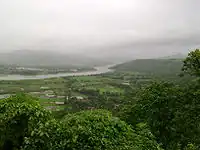 Visava | |
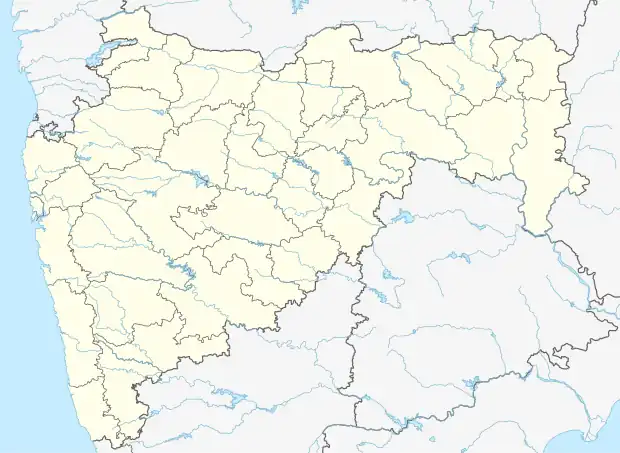 Chiplun Location in Maharashtra, India | |
| Coordinates: 17°32′N 73°31′E / 17.53°N 73.52°E | |
| Country | |
| State | Maharashtra |
| District | Ratnagiri |
| Government | |
| • Type | Municipal Council and Zilha Parishad |
| • Body | Chiplun Nagar Parishad (Urban) and Under Ratnagiri Zilha parishad in Rural area |
| Area | |
| • Total | 24.73 km2 (9.55 sq mi) |
| Elevation | 7 m (23 ft) |
| Population (2017) | |
| • Total | 35,000 |
| • Density | 1,400/km2 (3,700/sq mi) |
| Demonym | Chiplunkar |
| Languages | |
| • Marathi | Marathi |
| Time zone | UTC+5:30 (IST) |
| PIN | 415605 |
| Telephone code | 02355 |
| Vehicle registration | MH-08 |
| Website | Chiplun Instagram Account |

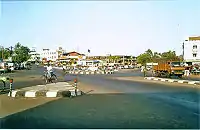
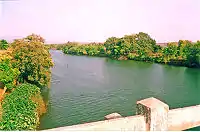
Chiplun (ⓘ [t͡ʃipɭuːɳ]) is a city in Ratnagiri district in the state of Maharashtra, India. It is one of the financial and commercial Hubs of Ratnagiri district, and the headquarters of Chiplun taluka. It is about 250 km south of Mumbai and 90 km North of Ratnagiri in the Konkan region of Maharashtra, on the Mumbai–Goa highway (NH-66). It has a long history and a strong cultural background. Recent decades have seen much industrial development in it and its and surrounding areas.
Geography
The city lies near the source of the Vashishti river. To the east of the city lie the Western Ghats and to the west lies Guhagar taluka which was carved out of Chiplun taluka. The region has a tropical climate. The 'rainy season' — the monsoon lasts normally from June until October. The Koyna Hydroelectric Power Project Stages III and IV are situated near Chiplun.
Religious significance
Chiplun was believed to have the first home of the Konkanasth or Chitpavan Brahmans. According to local folklore, after claiming Konkan region from the aggressive sea, people were supplied with sixty ponds and sixty gardens by Parashurama, the sixth incarnation of the Hindu god Vishnu.[1] Parashurama is believed to be the founder and creator of the Chitpavan Brahman community.
History
Chiplun was initially ruled by the Satavahanas, Shakas, Kshatrapas, Kalachuris, Chalukya, and Rashtrakutas. Later it was ruled by the Kadambas & Traikutas followed by the Delhi Sultanate, Marathas and Peshwas majorly.
Ancient history
Ancient texts mention Chiplun as a port.[2] During the rule of the Chalukya in 8th century, the place was called Chiprarulana.[3] An inscription called Chiplun stone which has a date of 1186 CE had the names of a Shilahara king and his ministers.[4]
Islamic era
In the seventeenth century it was a great village, very populous and plentifully stored with all provisions. The nearby Gowalkot was the trade center being the major harbour over Vashishthi River. The Paag area in town was named so because it was mainly used for war horse stables. The central area in Chiplun, called Markandi, is believed to have taken name from the Yadnya performed there by Maharshi Markandeya.
Maratha empire
In the recent history, when Shivaji took over Konkan and established his reign, he won the Gowalkot fort in 1660 and renamed it as Govindagad. During the times of Maratha Empire Chiplun was halting place when travelling towards upper ghat regions of Satara. Shivaji came to Gowalkoat fort in Chiplun to take an update of his Arm forces before going for his coronation at Raigad.
Chiplun was taken over later on by means of fort battles including Sambhaji, Tulaji Angre, Chimaji Appa, and Siddi Sat, before taken up by a body of Ramoshis in 1818, but abandoned on the approach of British forces.
During this time Peshwa Bajirao II, who for some years (1812-1815) came down the Kumbharli pass to visit his palace at Guhagar near Dabhol, built a rest house for himself which is now used as a Government office.
British colonial rule
The British colonial rule (1818-1947) saw large seasonal or permanent migration of people to the emerging Industrial city of Mumbai from Chiplun and other areas of Northern Konkan.[5]
Demographics
At the 2011 India census,[6] Chiplun had a population of 55,139 of which 27,355 are males while 27,784 are females as per the report released by Census India 2011. Literacy rate of Chiplun city is 93.92%, higher than the state average of 82.34%. In Chiplun, male literacy is around 96.50%, while female literacy is at 91.42%.[7]
Attractions
The Lokamanya Tilak Smarak Vachan Mandir library and Museum
The 155-year-old library in Chiplun called Lokmanya Tilak Smarak Vachan Mandir with a large collection of rare books added a museum in November 2018 to display its collection of ancient artifacts. This includes Stone Age tools, artifacts from Harappan culture, pottery of ancient Jorwe and Malwa cultures from Inamgaon excavation near Pune, articles from Maratha empire era and ancient statues of many gods and goddess discovered in the area. The museum also has a collection of coins ranging from Roman era to that of Maratha states.[8][9][10]
Akkalkot Swami Math
This Hindu hermitage or Math dedicated to Shri Swami Samartha was established by Shri Gopalbuva Kelkar alias Shri Preetinand Swamikumar Maharaj who authored a book about miracles done by Shri Swami Samartha. The Math showcases Swami Samartha's silver slippers and wooden dand (meditation arm-rest).
Parashurama Temple

This is one of the few temples that exist that of the Hindu deity Parashurama. It dates back to 1700 CE when it was built by Siddi Rasul Yakut Khan through the initiative from Swami Paramhans Brahmendra. This devotional place consists of a central shrine surrounded by two smaller buildings. The main temple has an idol of Parashurama in the centre, Brahma at the right, and Shiva on the left. The structure of the temple is influenced by Hindu, Muslim, and European architecture. The Banganga Talav is believed to be made by Parashurama by arching five arrows to the ground.
Shree Kulswamini Bhawani Waghjai Mandir
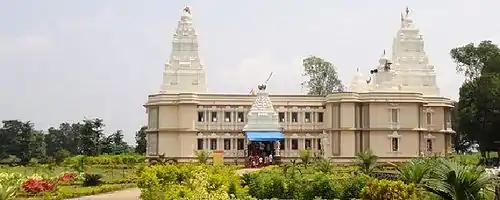
This newly renovated temple, which dates back to 1860, has been identified as a Government of Maharashtra's official tourist spot. The temple houses idols of four goddesses viz. Bhawani, Waghjai, Kalkai & Navdurga along with Lord Shiv Shankar. the temple also has Navdurga, nine forms taken by Goddess Parvati. The temple is surrounded by seven gardens.
Walavalkar Chhatrapati Shivaji Maharaj Museum
.jpg.webp)
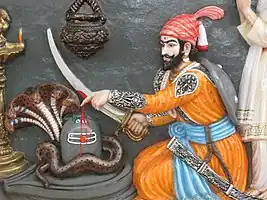
The Walavalkar Chhatrapati Shivaji Maharaj museum or Shivsrushti or Shiv-Samarth Mandir built by Shree sant Sitarambuva Walwalkar trust located at Dervan is one of the must-see locations when in Chiplun. The entire life history of Maratha king Shivaji is etched through sculptures and life sized statues with in detail expressions of characters including animals. The whole museum is formed as if a fort which brings the glory of Shivaji-era. In the temple premises, along with Shivaji, Sant Ramdas, Sant Tukaram and Sant Namdev are seen standing in their life-size forms. Bal Shivaji's naming Ceremony, his oath with his companions-at Rohideshwar as a child; he praying before the goddess Jagadamba, an encounter with Afzal khan, Baji Prabhu Deshpande's sacrifice, the coronation Ceremony; the re-acceptance of Netaji Palkar to the Hinduism, fight with Shahistekhan to name a few.
Shree Chandikai Kalkai Temple, Waghivare
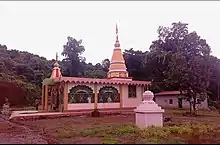
Shree Chandikai Kalkai is local deity of village Waghivare . This is a Hindu temple situated in a jungle on the border of Villages Waghivare and Vadad. Devotees believe that goddess is protecting them being on the border. Though the temple is dedicated to goddess Shree Chandikai Kalkai, there are idols of god Khem( खेम ), Kedar( केदार ), Som( सोम ) and goddess Waghambari( वाघांबरी),Vardhan( वर्धान ), Manai(मानाई ) also in the temple.
‘'Aai’' suffix means mother, who gives birth and protects the child from all kinds of difficulties and fulfils all wishes of devotees. Many devotees come here on Monday, Day of Goddess, for discussing problems and getting solutions from their mother, Shree Chandikai Kalkai Devi.
coordinates = 17°33′04″N 73°19′39″E / 17.5510166°N 73.3275111°E
Shree Hitvardhak Ganesh Temple, Madhaliwadi, Waghivare
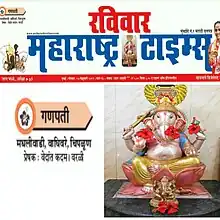
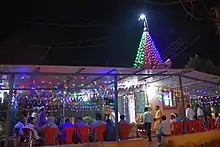
Transportation
Road
Chiplun is connected to other parts of the country mainly by National Highway 66 (NH-66). Chiplun is connected by road to Mumbai, Pune, Thane, Ratnagiri, Mangalore, Karwar, Udupi and Cochin by National Highway Number 17 (NH-17). The Konkan railway also connects to these places by train along with Delhi and Jaipur.
Roads in Chiplun city as well as in many villages is at par above average compared to road conditions in Mumbai. It is also connected to Koynanagar, Patan, and Karad by SH 78. There are several district roads which connect villages to district headquarters and Chiplun town.
There are two MSRTC bus stations. One is the main bus station frequently called "Khalcha" (juna) bus stand, and the other is just 2 km ahead of Main bus station called Shivaji Nagar Bus Stand.
Although there are lots of MSRTC intercity bus services, there are few private tourists buses such as Ghatge Patil, Sairatna, Ashwini etc. bus services which ply from Ratnagiri towards Mumbai & Pune.
Railways

Chiplun railway station is one of the most important stations on the Konkan Railway. The nearest railway junctions are Panvel, Pune and Kolhapur on the central railway. The Chiplun railway station is situated at a distance of 4 km from Chiplun city on NH-17. Nearly every train running on Konkan Railway stops at Chiplun Station.
| Chiplun (CHI) | |||
| Next 'Small' station towards Mumbai: Anjani |
Konkan Railway : Railway (India) | Next 'Small' station from Mumbai: Kamathe | |
| Distance from Mumbai(CST) = 292 km | |||
| Next 'Main' station towards Mumbai: Khed |
Konkan Railway : Railway (India) | Next 'Main' station from Mumbai: Ratnagiri | |
See also
References
- ↑ Pusalker, A. D.; Dighe, V. G. (1949). Bombay: Story of the Island City. All India Oriental Conference, Bombay.
- ↑ Deshpande, Aniruddha; Deo, Sushama G.; Ghate, Savita (2008). "Geoarchaeological Investigations in North Konkan, Maharashtra". Bulletin of the Deccan College Research Institute. 68/69: 71–80. JSTOR 42931196.
- ↑ Habib, Irfan; Habib, Faiz (1999). "India in the Seventh Century — A Survey of Political Geography". Proceedings of the Indian History Congress. 60: 89–128. JSTOR 44144078.
- ↑ Shah, Viraj (2009). "A Study of Temples of Medieval Maharashtra (11th to 14th Centuries CE) A Socio-Economic Approach". Post-Doctoral Report: 47.
- ↑ Yamin, G. M. (July 1991). The causes and processes of rural-urban migration in 19th and early 20th century India : the case of Ratnagiri district (Thesis). ProQuest 2512354887.
- ↑ "Census of India 2001: Data from the 2001 Census, including cities, villages and towns (Provisional)". Census Commission of India. Archived from the original on 16 June 2004. Retrieved 1 November 2008.
- ↑ "Chiplun Municipal Council City Population Census 2011-2021 | Maharashtra".
- ↑ Sakal Paper about Chiplin Museum
- ↑ Lokasatta about Chiplin Museum
- ↑ Chiplun Museum